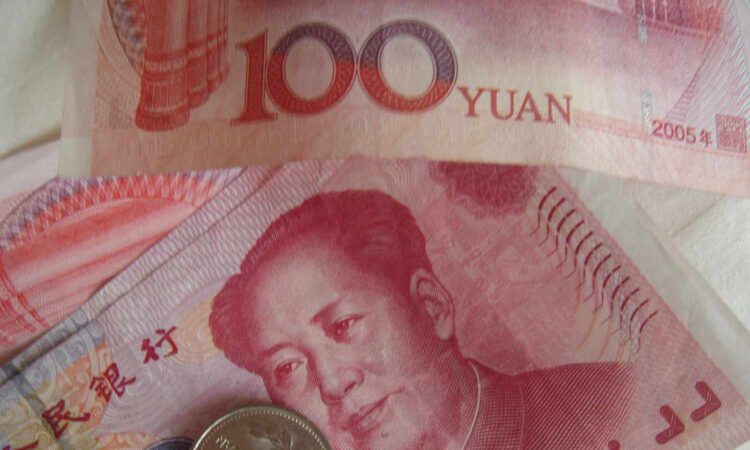
What Is China’s Currency Peg?
The Chinese yuan has had a currency peg since 1997. It used to peg its currency to the U.S. dollar but since 2005 it has managed its currency against a basket of currencies with weightings determined by levels of trading with its foreign partners. The currency is not allowed to float more than 2% against a fixed level.
This approach keeps the value of the yuan low compared to other countries. The effect on trade is that Chinese exports are cheaper and, therefore, more attractive compared to those of other nations. By motivating the global marketplace to buy its goods, China ensures its economic prosperity.
Key Takeaways
- A currency peg is a monetary policy that keeps the value of a currency low compared to other countries.
- China pegged its currency from 1997 to 2005 to the U.S. dollar but since has managed its currency against a basket of currencies.
- The effect of the peg and the low currency is that Chinese exports are cheaper and, therefore, more attractive compared to those of other nations.
- By exporting more goods, China’s economy thrives.
Understanding China’s Currency Peg
As long as a currency peg keeps the yuan low relative to other currencies, consumers using foreign currencies can buy more of China’s exports than they would if the yuan was more expensive. Specifically, if the People’s Bank of China keeps the yuan weak compared to the U.S. dollar, consumers using the greenback can buy more Chinese exports.
Exports are a major driver of any economy because they represent money flowing into a nation. To keep the yuan artificially low and support robust export activity, the People’s Bank of China engages in currency purchases. In the 10 years from 2004 to 2014, the foreign exchange reserves (minus gold) owned by China’s central bank surged from roughly $615 billion to $3.9 trillion. After 2014, the levels started to come down, dropping to $3.13 trillion in 2022 (latest data).
Economic Boom
Currency manipulation has helped China thrive as its economy has repeatedly experienced robust growth rates hovering around 10% from 1995 to 2010. Since 2010, however, China’s growth rates have been decreasing, hovering around 7%, with continued decreases after the pandemic, to 3% in 2022 (latest data). Reasons for the slowing growth are many, including an aging population, structural issues, and inefficiencies of state-led economic policies.
Due to robust growth from the 1990s onwards, China’s gross domestic product (GDP) per capita increased from $474 in 1994 to $12,720 in 2022, an increase of more than 2,500% in 28 years. By comparison, the United Kingdom’s GDP per capita only increased 134% during the same period.
Costs and Benefits
While these facts and figures are generally positive for China, that is not the case for everyone. U.S. manufacturers and workers have complained about the Chinese trade surplus, claiming that the yuan peg has granted Chinese companies an unfair advantage. As a result, U.S. lawmakers have called for the revaluation of China’s currency.
While opponents of yuan pegging have complained, they may be oversimplifying the situation. An artificially low yuan is not without its benefits. The currency peg means cheap Chinese goods for U.S. consumers, a development that can help keep overall inflation at a modest level.
The benefits of less expensive goods extend to businesses. U.S. companies that use less expensive imported items from China to make goods enjoy reduced production costs. With lower expenses, firms can either lower the prices for consumers, increase their profits, or both.
Chinese trade deficits also provide a boon to the broader economy as they necessitate the movement of capital to the United States from China. If this foreign capital goes toward purchasing interest-bearing securities, such as U.S. Treasuries, this creates downward pressure on borrowing costs and encourages stronger investments. In addition, lower interest rates support economic growth.
Is the Yen Pegged to the Dollar?
No, the Japanese yen is not pegged to the dollar. It is a free-floating currency, like the dollar, whose value is determined by its supply and demand in the market.
What Is a Currency Peg?
A currency peg is when a nation fixes the exchange rate of its currency to that of another currency. This means that the currency is not free-floating and the exchange rate won’t change, regardless of supply and demand. The main goal of a peg is to ensure the stability of the exchange rate between two countries, primarily those that are large trading partners with one another.
Is China’s Currency Backed by Gold?
No, China’s currency is not backed by gold. It is a mix of a currency that is pegged and free-floating. It is pegged to a basket of goods, where the value is allowed to float no more than 2% against a fixed value that is set daily.
The Bottom Line
Pegging the yuan is a strategic policy move that provides crucial benefits to the Chinese economy. Using this approach, the People’s Bank of China increases the appeal of Chinese exports in the global marketplace and helps fuel greater prosperity for China. While many governments harness expansionary policies in the hope that they will generate the intended results, China has proved the efficacy of its currency peg over many years.



